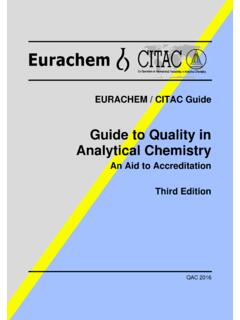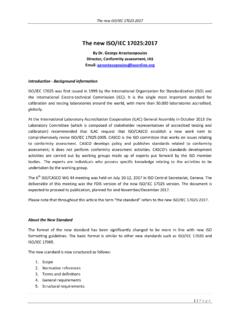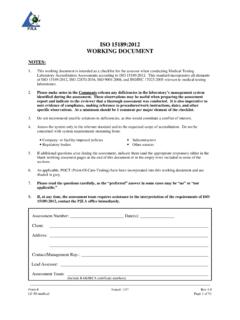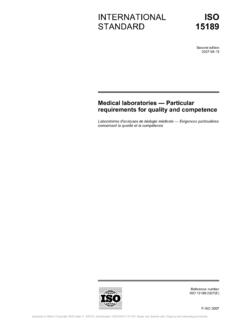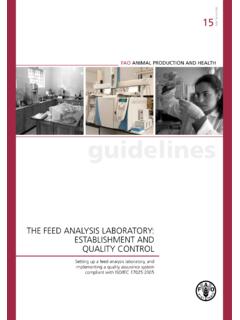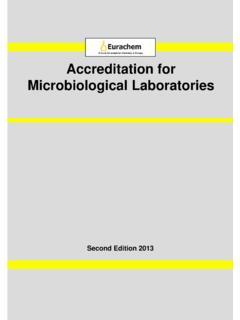Transcription of Main changes introduced in Document Nº …
1 Main changes introduced in Document N SANTE/12682/2019 with respect to the previous version ( Document N SANTE/11813/2017) 1) Amendments which are concerned with editorial improvements throughout the Document . 2) The reference to the legislation in A3 has been updated. 3) B1 The contribution from sampling to MU will not be included in the Document . Sampling is not a part of the measurement. The samples should be taken according to the Commission Directive 2002/63/EC and Regulation (EC) No 152/2009. A sentence is added to the paragraph B1. 4) Calibration and quantification The definition of Representative analytes for calibration has been deleted.
2 The proposal is that all analytes must be calibrated in every batch of samples, accordingly Table1 is superfluous. 5) A new paragraph (C47) has been added to emphasize the need for calibration standards to be put in the beginning and in the end of the sample sequence to ensure the detectability of the analytes. 6) In Table 2 (previously Table 3) regarding the screening, the recovery check has been changed to detectability check. The number of analytes for the recovery check is proposed to be 10 % per detection technique in accordance with Table 1 (recovery check for quantitative methods). 7) D12 The requirement of a generic value of 30 % for the ion ratio has been deleted.
3 However, the ion ratio can still provide additional evidence for identification. 8) Reporting results New paragraphs E4-E6 have been added to clarify the different approaches to correct the residues, when the mean recovery is outside of 80-120 %. 9) E10 Clarification of the MU components (in Appendix C), which can be used for the estimation of the MU. 10) G6 has been rewritten. 11) Screening methods G8-G12. The paragraphs have been restructured. 12) Appendix C. Examples for the estimation of measurement uncertainty of results The Appendix C is rewritten and restructured. Two approaches are presented with examples of calculations.
4 The first approach deals with MU estimation based on intra-laboratory QC data for individual pesticides in a commodity group. The second approach deals with a generic MU for the multi-residue method based on an overall combination of intra-laboratory precision. 13) Appendix D. Example of rounding, reporting and interpreting results A new Appendix D has been added to clarify the rules for rounding of the results. The appendix gives also advice how to interpret the results with regards the measurement uncertainty and compliance of the results. 14) Glossary: updated ANALYTICAL QUALITY CONTROL AND METHOD VALIDATION PROCEDURES FOR PESTICIDE RESIDUES ANALYSIS IN FOOD AND FEED Supersedes Document No.
5 SANTE/2017/11813. Implemented by 01/01/2020 Coordinators: Tuija Pihlstr m Swedish Food Agency, SFA, Uppsala, Sweden Amadeo R. Fern ndez-Alba EURL-FV, University of Almer a, Almer a, Spain Miguel Gam n EURL-FV, Generalitat Valenciana, Valencia, Spain Carmen Ferrer Amate EURL-FV, University of Almer a, Almer a, Spain Mette Erecius Poulsen EURL-CF, DTU National Food Institute, Lyngby, Denmark Ralf Lippold EURL-AO, CVUA Freiburg, Freiburg, Germany Michelangelo Anastassiades EURL-SRM, CVUA Stuttgart, Fellbach, Germany Advisory Board: Andr de Kok Wageningen Food Safety Research, Wageningen, The Netherlands Finbarr O Regan Pesticide Control Laboratory, DAFM, Kildare, Ireland Patrizia Pelosi Natonal Institute of Health, ISS, Rome, Italy Antonio Valverde University of Almer a, Almer a, Spain Sonja Masselter AGES, Institute for Food Safety, Innsbruck, Austria Hans Mol Wageningen Food Safety Research, Wageningen, The Netherlands Magnus Jezussek LGL, Erlangen, Germany Table of Contents A.
6 Introduction and legal background 1 B. Sampling, transport, traceability and storage of laboratory samples 2 Sampling 2 Transport 2 Traceability 2 Storage 2 C. Sample analysis 3 Sample preparation and processing 3 Pooling of samples 3 Extraction 4 Extraction conditions and efficiency 4 Clean-up, concentration/reconstitution and storage of extracts 4 Chromatographic separation and determination 4 Calibration for quantifcation 5 General requirements 5 Analytes for calibration 6 Matrix-matched calibration 6 Standard addition 6 Effects of pesticide mixtures on calibration 7 Calibration for pesticides that are mixtures of isomers 7 Procedural Standard Calibration 7 Calibration using derivative standards or degradation products 7 Use of various internal standards 7 Data processing 8 On-going method performance verification during routine analysis 8 Quantitative methods 8 Screening methods 10 Proficiency testing 10
7 D. Identification of analytes and confirmation of results 11 Identification 11 Mass spectrometry coupled to chromatography 11 Confirmation of results 13 E. Reporting results 14 Expression of results 14 Calculation of results 14 Correction for recovery 14 Rounding of data 15 Qualifying results with measurement uncertainty 15 Interpretation of results for enforcement purposes 16 F. Pesticide standards, stock solutions and calibration standard solutions 17 Identity, purity, and storage of reference standards 17 Preparation and storage of stock standards 17 Preparation, use and storage of working standards 18 Testing and replacement of standards 18 G.
8 Analytical method validation and performance criteria 20 Quantitative methods 20 Method performance acceptability criteria 20 Screening methods 21 Method performance acceptability criteria 22 H. Additional recommendations 23 Contamination 23 Interference 23 Annex A. Commodity groups and representative commodities 24 Appendix A. Method validation procedure: outline and example approaches 27 Appendix B. Examples of conversion factors 30 Appendix C. Examples for the estimation of measurement uncertainty of results 32 Appendix D. Example of rounding, reporting and interpreting results 39 Appendix E. Glossary 41 1 of 49 ANALYTICAL QUALITY CONTROL AND METHOD VALIDATION PROCEDURES FOR PESTICIDE RESIDUES ANALYSIS IN FOOD AND FEED A.
9 Introduction and legal background A1 The guidance in this Document is intended for laboratories involved in the official control of pesticide residues in food and feed across the European Union. This Document describes the method validation and analytical quality control (AQC) requirements to support the validity of data reported within the framework of official controls on pesticide residues, including monitoring data sent to the European Food Safety Authority, and used for checking compliance with maximum residue levels (MRLs), enforcement actions, or assessment of consumer exposure.
10 The key objectives are: to provide a harmonized, cost-effective quality assurance and quality control system across the EU to ensure the quality and comparability of analytical results to ensure that acceptable accuracy is achieved to ensure that false positives or false negatives are avoided to support compliance with, and specific implementation of ISO/IEC 17025 (accreditation standard) A2 The glossary (Appendix E) should be consulted for definitions and explanation of terms used in the text. A3 This Document is complementary and integral to the requirements in ISO/IEC 17025 . It should thus be consulted during audits and accreditations of official pesticide residue laboratories according to ISO/IEC 17025 .










